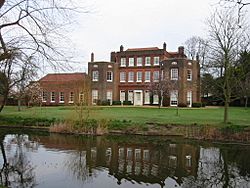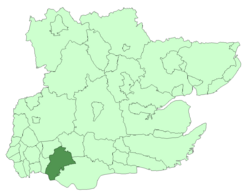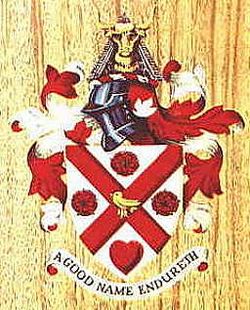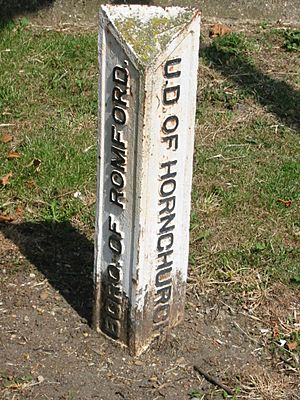Hornchurch Urban District facts for kids
| Hornchurch | |
| Motto: A good name endureth | |
 |
|
 |
|
| Geography | |
| Status | Urban district |
| 1931 area | 6,783 acres (27.4 km2) |
| 1961 area | 19,768 acres (80.0 km2) |
| HQ | Langtons House, Hornchurch |
| History | |
| Origin | Hornchurch civil parish |
| Created | 1926 |
| Abolished | 1965 |
| Succeeded by | London Borough of Havering |
Quick facts for kids Demography |
|
|---|---|
| 1931 population - 1931 density |
28,417 4/acre |
| 1961 population - 1961 density |
131,014 6.6/acre |
| Politics | |
| Governance | Hornchurch Urban District Council |
 |
|
Hornchurch was a special local government area in southwest Essex, England. It existed from 1926 to 1965. It started as an "urban district" (a type of local government area) for the town of Hornchurch. The area grew a lot in 1934 and 1935, adding nearby places like Cranham, Rainham, Upminster, and North Ockendon.
The council that ran Hornchurch, called the Hornchurch Urban District Council, had its main office at Langtons House from 1929. Hornchurch became a suburb of London. Its population grew to over 131,000 by 1961, making it one of the biggest urban districts in England. Today, most of this area is part of the London Borough of Havering in Greater London.
Contents
History of Hornchurch's Local Government
Early Beginnings
The old area of Hornchurch was once part of a special region called the Royal Liberty of Havering. This area had been around for a very long time. Over the years, parts of Hornchurch, like Havering-atte-Bower and Romford, became their own separate areas.
By 1894, Hornchurch became part of the Romford Rural District. This meant it was managed by the Romford council, which looked after countryside areas. At this time, the Hornchurch Parish Council was created to handle local matters. The first election for this council happened in December 1894, with thirteen councillors chosen.
Becoming an Urban District
In 1911, the Hornchurch Parish Council started thinking about becoming an "urban district." This would give them more control over their own area, like managing building projects. Some people worried this might make local taxes go up.
By 1925, many new houses were being built in Hornchurch. This made the idea of having more local control even more important. After a vote, the parish council decided to apply to become an urban district. Even though the Romford Rural District Council and some local groups were against it, Hornchurch officially became an urban district on 1 April 1926. This meant it was no longer part of the Romford Rural District.
Changes and Growth in the 1930s
After a new law in 1929, county councils had to review their districts. The goal was to combine smaller councils or change boundaries to make things work better. In 1929, Hornchurch Urban District Council wanted to join with Upminster and Cranham.
In 1934, the Hornchurch urban district grew much larger. It gained about 11,687 acres (47.3 km²) from the Romford Rural District. This included all of Rainham and Wennington, and most of Upminster, Cranham, and Great Warley. In 1935, it grew again, adding about 1,326 acres (5.37 km²) from North Ockendon.
Joining with Romford
In 1948, there was a suggestion to merge Hornchurch with Romford to create a new, bigger area. Hornchurch Urban District Council didn't like this idea and wanted to become its own "municipal borough" (a type of town with its own mayor and special powers). They tried to get this status in 1955, but it was refused. The government wanted to review how local areas were run in the Greater London region first.
A special group, the Royal Commission on Local Government in Greater London, looked at Hornchurch. They suggested that Hornchurch should become a borough within a new Greater London area. Hornchurch Urban District Council supported moving to Greater London, but Essex County Council did not.
The London Government Act 1963 led to the creation of larger boroughs. Hornchurch (with a population of 131,014 in 1961) was planned to merge with Romford (with a population of 114,584). This new area was named the London Borough of Havering. The new Havering London Borough Council was elected in 1964. It officially took over in 1965, when Hornchurch Urban District and the Municipal Borough of Romford became part of Greater London.
Geography of Hornchurch
When Hornchurch became an urban district in 1926, it included Harold Wood in the northeast. It stretched south through the main town of Hornchurch all the way to South Hornchurch and the River Thames.
The population of Hornchurch grew very quickly in the 1930s. This was because many new houses were being built in the suburbs around London. Also, new factories were opening in Outer London, like the Ford Motor Company plant in Dagenham. Many Londoners moved to these new suburban areas to live closer to their jobs.
Transportation also improved. The railway line through the district was made electric in the 1930s. New train stations opened at Elm Park and Upminster Bridge. These joined the older stations at Hornchurch and Upminster.
Hornchurch Urban District Council
The Hornchurch Urban District Council was first elected on 27 March 1926. It took over from the Hornchurch Parish Council on 1 April. Thirteen councillors were elected from four existing areas called wards.
After the district grew in 1934, it was divided into eight wards. These wards elected 21 councillors:
| Ward | Electors | Councillors |
|---|---|---|
| Cranham | 869 | 1 |
| Emerson Park | 4263 | 3 |
| Harold Wood | 2744 | 2 |
| North West | 7176 | 5 |
| Rainham | 2779 | 2 |
| Thameside | 1631 | 1 |
| Town | 5700 | 4 |
| Upminster | 4513 | 3 |
In 1948, the number of councillors increased to 27. By 1952, there were nine wards, electing a total of 30 councillors. In 1958, the number of wards increased to 10, and the 30 councillors were spread out among them.
Political Control of the Council
Different political groups controlled the council at different times:
- Hornchurch Ratepayers' Association: 1926
- Labour Party: 1946–48
- Conservative Party: 1949–54
- Labour Party: 1954–55
- Conservative Party: 1955–56
- Labour Party: 1956–60
- No overall control (meaning no single party had a majority): 1960–65
Community Projects and Buildings
The council did many things for the community:
- It ran the Queen's Theatre, Hornchurch.
- It built Hornchurch Stadium in Upminster.
- It created several parks, including Harrow Lodge Park, Haynes Park, Hylands Park, and St Andrew's Park.
- Hornchurch Swimming Pool opened in 1957. It was the first new swimming pool built in the country after the Second World War.
Housing Projects
In 1926, the urban district had 464 council houses. The council built 150 more houses before the Second World War. After the war, between 1945 and 1965, they built another 3,000 homes for local residents.
Parliamentary Representation
Hornchurch was part of the Romford area for choosing Members of Parliament (MPs). In 1945, the Hornchurch constituency was created. This new area matched the boundaries of the urban district.
Population Changes
The population of Hornchurch grew steadily over the years:
| Year | 1891 | 1901 | 1911 | 1921 | 1931 | 1939 | 1941 | 1951 | 1961 |
|---|---|---|---|---|---|---|---|---|---|
| Population | 3,841 | 6,402 | 9,461 | 10,891 | 28,417 | 81,486 | 104,092 | 131,014 |
In 1931, the areas added in 1934 (Cranham, Great Warley, Rainham, Upminster, and Wennington) had a combined population of 11,121 people.
Legacy of Hornchurch Urban District
In 1993, some of the eastern parts of the former urban district, around Great Warley, were transferred back to Essex.


